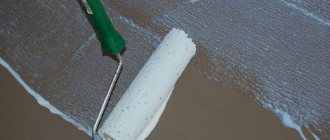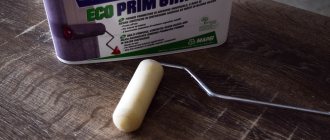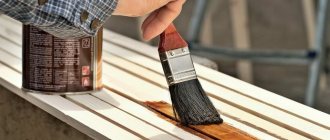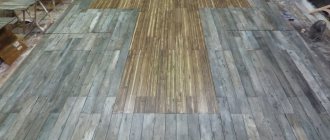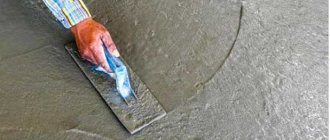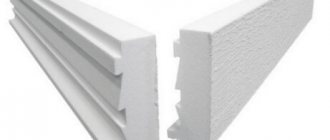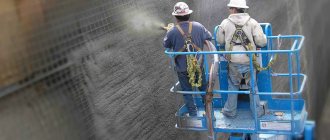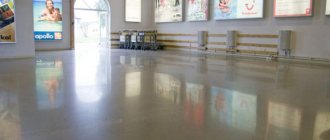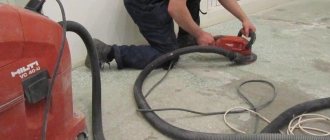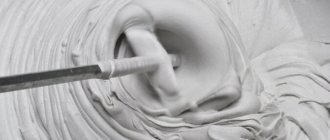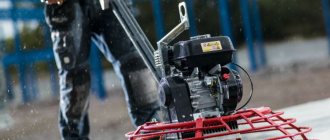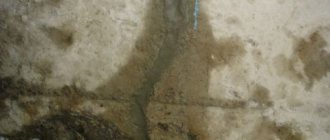Concrete is a fairly porous building material. Its further strength and durability will depend on compliance with all technical installation processes. If during the work you neglected one of the stages, such a coating will soon become unusable from exposure to moisture and air, and microcracks will appear during operation. Impregnation for concrete strengthens the coating, protects it from destruction and improves its appearance.
Essentially, after processing, the material becomes a hard, waterproof stone.
The strengthening mixture allows you to solve the following problems:
- Protect the coating from dust, cracks and potholes.
- Increase the wear resistance and strength of the concrete coating.
- Strengthens aged concrete surfaces.
- Create a beautiful decorative floor surface.
On the video: characteristics and properties of impregnation for concrete.
Why are concrete hardeners needed?
Impregnations for concrete are synthesized in the form of liquid compositions containing special adhesive components that increase the properties of the top layer of the base surface. The structure of the material is loose, porous, with a large number of micropores.
Such features cause disadvantages of concrete structures:
- insufficiently high density, leading to a deterioration in the strength characteristics of the finished structure;
- low water-repellent ability, hydrophobicity - moisture seeps through the pores of the artificial stone.
High-quality impregnations create a beautiful uniform gloss or noble matte surface. The treated surface does not slip even when wet
Modern technologies for the protection of reinforced concrete products make it possible to upgrade the porous surface of concrete structures into waterproof stone . The use of impregnations (primers) is indicated in the construction of monolith walls, load-bearing structures, concrete foundations and other structural elements in contact with moisture.
Tasks that the material allows you to implement:
- fill voids, protecting the base from the effects of chemicals and negative environmental factors;
- dust removal;
- protection against moisture (impregnation blocks the penetration of water);
- increasing the strength of concrete structures;
- increasing the wear resistance of concrete slabs and screeds;
- strengthening structures and products that are in long-term operation;
- increasing maintenance-free operation of reinforced concrete products;
- improvement of aesthetic characteristics.
Classification
Based on the composition of the material, it is divided into two types of compositions:
- modifiers of inorganic origin;
- organic mixtures.
Organic options - main characteristics:
- these are liquid materials made on the basis of acrylic, epoxy resins, polyurethane (acrylic, epoxy, etc.);
- primers of this type fill the pores of concrete, due to which the surface acquires the ability to resist aggressive environments and repel water;
- the surface becomes durable and dust-free.
When calculating the required volume of material, the grade strength of the material to be processed and the number of layers should be taken into account. The lower the brand, the higher the consumption of the composition
Polyurethane impregnation for concrete is a universal product. The binder, absorbed into the concrete, copes with all the tasks. Compositions based on other components are most often characterized by a more narrowly targeted effect.
Inorganic modifiers - basic properties:
- This group includes silicate impregnations (impregnation of concrete with liquid glass);
- the product does not fill pores, but reacts with the molecular compounds of concrete;
- As a result, the base becomes inert to other reactions, acquires strength, water resistance, and dust removal.
Next we consider how the material is classified according to its functional purpose.
Classification of impregnations
Based on their content, impregnating compositions are divided into two types:
- organic (polymer);
- inorganic (silicate).
Organic water-repellent solutions affect concrete in the following way: the binder component fills the pores, improving the material’s ability to withstand aggressive influences and enhancing the water-repellent qualities of the coating. Impregnations also solve the problem of surface dustiness and improve its strength characteristics.
Inorganic impregnating compounds act differently. They do not target pores, but interact with external molecular compounds, which then dissolve and become immune to other reactions. As a result of the interaction, concrete gains higher strength and water resistance.
When choosing an impregnating material, it is recommended to take into account the following factors:
- Inorganic compositions are used for: dust removal at low cost, with significant surface unevenness, with heavy loads on the floor.
- Organics are relevant in the following cases: constant interaction with chemicals, maintaining an attractive appearance of the coating, the need for dust removal from mosaics.
Today, organics are the most common. This is due to the better functional characteristics of organic compounds.
Different impregnations differ in the method of influencing the concrete base:
- Deep penetration impregnating compounds (silicates, silaxins, silanes) promote the fluidization of concrete. The sealing components penetrate microscopic pores and interact with lime molecules, increasing the crystallization of calcium. Thus, fluates strengthen the material from the inside.
- Liquid waterproofing compounds form a thin protective film. An example is impregnation based on acrylates. Epoxy mixtures and numerous types of polyurethane impregnations also work.
Acrylic compounds
Impregnations based on acrylates are distinguished by affordable prices and acceptable quality. They protect the material from moisture and chlorides, are resistant to ultraviolet radiation, and preserve the natural color of concrete. Acrylic compounds allow you to remove dust from the coating. However, impregnations of this type are short-lived - their effect lasts no more than 24-36 months.
Polyurethane compounds
Polyurethane is more effective than acrylates. Impregnating solutions based on polyurethane remove dust from the surface, are resistant to chemicals, are moisture resistant, and provide strength. Polyurethane solutions are used to treat not only concrete, but also cement screeds, paving areas, stone and brick objects. Polyurethane penetrates deeply into the concrete layer (up to 6 mm) and is used both indoors and outdoors.
Note! The use of polyurethane compounds implies the presence of a waterproofing layer under the concrete base, which blocks the penetration of capillary moisture into the structure of the material.
After treatment with a polyurethane solution, concrete acquires several new qualities:
- Strength increases to M600 level;
- wear resistance increases by 7-10 times;
- Impact resistance doubles;
- water resistance and resistance to chemicals are improved;
- dust is eliminated;
- maintenance of the coating becomes easier;
- the appearance of the surface becomes more attractive.
Polyurethane impregnating compounds are easy to use and financially beneficial. The impregnated surface begins to be used on the same day, if we are talking about pedestrian traffic. In the case of transport, you need to wait three days for the concrete to gain maximum characteristics.
Epoxy compounds
Impregnations based on epoxy resin are used only indoors, as they do not withstand exposure to ultraviolet radiation and turn yellow. The composition is a mixture of two components, which includes epoxy resin and hardener. The latter are phenols or tertiary amines. The proportions between the hardener and resin may differ depending on the consumer characteristics of the product. Compositions are offered in both colored and colorless versions.
The advantages of epoxy impregnations include the following qualities:
- high strength;
- resistance to abrasives;
- moisture resistance;
- slight shrinkage;
- no pungent odor;
- attractive appearance, as the surface resembles “wet concrete”.
The disadvantage of epoxy compounds is that they are less resistant to chemicals and mechanical loads when compared with polyurethane impregnations.
Strengthening impregnation
As a rule, such compositions are based on silicate soil mixtures. Impregnation is transported deep into the material and changes its structure . This property prevents the primer from peeling, provides high wear resistance, and complete dust removal. It is recommended for finishing walls, ceilings, floors, supports and other structural elements.
Deep penetration strengthening compounds
Deep impregnations can increase the strength properties of the surface layer up to three times. This is a traditional material for processing concrete, made on potassium and sodium bases.
Such compositions have been replaced by innovative concrete hardeners (strengthening impregnations for concrete) based on lithium silicates. Lithium impregnation for concrete protects against mechanical abrasion, dust formation, and moisture. The use of such compositions eliminates the risk of efflorescence , although the price is higher. The structure is ready for use two hours after finishing the treatment.
IMPREGMENTS FOR CONCRETE FLOORS
Concrete impregnation – a reliable floor for every home!
Impregnations for concrete NPP GC - prices
Impregnation for concrete is a strengthening composition for a material such as concrete, the basis of which is a solvent or water. The principle of operation of this composition is that, penetrating into the pores of the material, the concrete impregnation polymerizes, thus binding the particles that make up the concrete surface. Thus, concrete impregnation helps to improve concrete floors, increasing their service life, increasing wear resistance, reducing the formation of dust on the surface and improving adhesion between the base and the adjacent coating. Concrete impregnation treatment is one of the most important processes in surface preparation before concrete is covered with paint, varnish or other coatings.
“Protector-AQUA” is a strengthening impregnation of concrete , which is intended for both indoor and outdoor work, and in rooms with high humidity. The use of this impregnation for concrete eliminates dust, strengthens the surface of the concrete floor, and reduces the formation of microcracks in concrete. The use of "Protector-AKVA" concrete impregnation helps strengthen crumbling and loose foundations. A distinctive feature of this impregnation is that it can be used on brick, concrete, plaster, wood and other surfaces. Impregnation of concrete with the material "Protector-AQUA Impregnation" helps to increase adhesion between the base and the adjacent coating. The small particle size of this dispersion allows the impregnation to penetrate quite deeply into the base. And because this concrete impregnation does not contain organic solvents, it does not have a pungent odor. At the same time, in order to strengthen the surface of concrete coatings, “Protector” concrete impregnation .
Impregnation Interhard
455 rub./l, packing 10 l
Universal, deeply penetrating hardening impregnation for lithium-based concrete. It is used to improve the performance properties of concrete floors and coatings in garages, parking lots, industrial and warehouse premises, has a good strengthening effect on weak concrete, and is suitable for rooms with high humidity, concrete coatings of piers. Can be used both for strengthening unpainted concrete floors and for painting with enamels and applying polymer coatings
Protector-AQUA impregnation
145 rub./l, packing 10 l
This impregnation is used to strengthen concrete surfaces both indoors and outdoors. The advantage of this concrete impregnation is the ability to use it in rooms with high humidity. An ideal material for preparing surfaces for painting with water-dispersion paint “Protector-AKVA enamel” and similar, including façade water-dispersion paints. Impregnation is intended to strengthen the concrete surface, reduce dust and the formation of microcracks. Strengthens loose and crumbling concrete bases. Suitable for plaster, brick, concrete, wood and other surfaces. Increases adhesion between the base and subsequent coatings. Due to the very small particle size of the dispersion used, the impregnation penetrates deep into the base. Does not contain organic solvents, no pungent odor.
Impregnation for concrete floors "Protector"
189 rub./l, packing 20 l
Impregnation for concrete "Protector" is designed to strengthen the surface of concrete. Creates a protective layer that is resistant to chemical attack and ensures a dust-free surface. With the help of “Protector” impregnation, the properties of concrete floors are improved, since it provides an increase in service life and increased wear resistance, a reduction in dust formation on the surface and the penetration of dirt into the interior, improves adhesion between old and new concrete, and ensures the “breathing” properties of concrete.
Impregnation for concrete floors "Vepox-W"
409 RUR/l, packing 20 l
Two-component impregnation for concrete floors. Does not contain organic solvents (water-based). Suitable for application on wet concrete. Water-epoxy impregnation Vepox-W for preparation for painting concrete floors, walls and other cement-based substrates. An ideal base for Vepox epoxy enamel. Vepox-W is used in industrial, residential and public premises, in the food and pharmaceutical industries, children's and medical institutions. Suitable for painting outdoors. It is used as a primer layer on wet concrete (from 14 days), as well as surfaces with capillary moisture suction, resistant to mold.
PU-555 impregnation
234 RUR/l, packaging 20 l
One-component strengthening impregnation for concrete floors. Penetrates deeply into the surface of concrete, strengthening the top layer. Used on porous concrete bases, if necessary, treatment is carried out 2-3 times.
Water-repellent impregnation
Compositions that increase hydrophobic properties penetrate into the pores and cracks of the base base.
Such measures protect the surface from deep penetration of moisture and a number of negative factors:
- acid, salt precipitation;
- waterproofing impregnation for concrete protects against fungus, mold, microorganisms;
- hydrophobic impregnation protects against the appearance, efflorescence and cracks;
- UV protection.
Polyurethane impregnations are fire hazardous in an uncured state. When the container is opened, the use of a tool that produces a spark upon impact is unacceptable.
A hydrophobic product for stone, concrete and brick, intended for outdoor use, increases thermal insulation properties and frost resistance. The composition protects structures from the inside, which is important when carrying out repairs of basements, plinths, and monolithic walls.
It is important to understand that the most modern composition will not protect the foundation from the penetration of groundwater (the foundation needs high-quality waterproofing). The maximum degree of protection can be obtained by purchasing two-component compounds for concrete against water , intended for the treatment of hydraulic structures.
Protection of concrete walls and façade coverings
We offer a wide range of Litos-type impregnations - water repellents and facade cleaners. This hydrophobic treatment of facades is an effective means of protecting them from moisture penetration and maintaining a decent appearance for many years. Waterproofing Aquabarrier is a universal protective impregnation for concrete and many other building materials.
Concrete is a unique material for construction work, but it is also susceptible to moisture. Water-repellent impregnation of concrete structures can significantly increase its durability.
Dust-removing impregnation for concrete
Dust-removing primers penetrate into the thickness of concrete to a depth of 2-6 cm . The use of such a composition is relevant for the treatment of utility, warehouse, and livestock premises. Dust removal of the ceiling, floor, and walls is necessary before working with paints, plasters, and polymer coatings.
Efficiency of anti-dust modifiers:
- facilitating the maintenance of concrete surfaces;
- elimination of dust formation;
- extension of the operational period;
- impregnation for concrete against dust helps to increase wear resistance;
- preventing the destruction of the base from exposure to oils, acids, alkalis.
Additives for concrete
Hydrophobic concrete additives are mixed with other ingredients during the preparation of the concrete mixture and are incorporated into the structure, ensuring water resistance. The most effective compositions are used for foundations and in the construction of swimming pools, water storage facilities, etc. The principle of their protective effect is based on the formation of a crystalline structure that prevents the penetration of moisture, for example, based on ettringite or silicates. High results are achieved when using the Penetron ADMIX mixture as an additive for concrete. The more economical composition Crystal is used as a hydrophobic additive and anti-corrosion protection of metal reinforcement; at the same time, it is able to raise the water resistance class of the material by 3-4 categories.
The principle of protecting concrete from moisture using bridging additives.
Mineral impregnation. Water-repellent impregnation of concrete is intended to protect the building structure after its formation. It penetrates the material to a certain depth and creates a barrier to water penetration. The impregnating composition may have a different base and protection mechanism. Mineral impregnation, coming into contact with penetrating water, creates compounds that prevent further passage of moisture. Such substances can also be used at the stage of mixing the concrete mixture.
The Monolit-20M impregnating solution penetrates into the finished concrete structure to a depth of 25 mm, filling all pores and microcracks. The resulting gel seals the surface layer of the material, creating an obstacle that is insurmountable for water. Water-repellent impregnation for concrete such as Granit-28 or Aqua-Top forms a protective layer of calcium silicate on the surface, which not only increases waterproofing properties, but also provides corrosion protection for reinforcement and mechanical strengthening of the surface layer of concrete. This outer layer achieves a compressive strength of 80 MPa.
Impregnating compositions based on organosilicon compounds are widely used. Such a substance, penetrating into the thickness of concrete to a depth of 20-25 mm, is evenly distributed throughout the volume and hardens according to the principle of polycondensation. A waterproofing layer is formed, as well as a barrier for efflorescence to escape; the layer is vapor permeable.
Fungi or mold cannot form on the treated surface.
Correct position of the spray gun during operation.
The standard organosilicon compounds Kristallizol and Monolit-Hydro have proven themselves to be quite reliable.
Silicone impregnating water repellent is reliable protection against the effects of natural conditions - snow, rain, frost. It penetrates deep into the concrete structure to a distance of about 6-8 mm, as a result of which a transparent protective film is formed on the surface, preventing even the smallest particles of moisture from penetrating into the pores and capillaries of the material.
When water repellents are introduced into concrete, its thermal insulation properties are improved and frost resistance increases. The impregnation components are not washed out of the base material for many years; they are colorless and will not affect the palette of facing coatings. Standard formulations include AVIS, Litos, and Aquabarrier. For example, AVIS, penetrating into concrete, forms protective siloxane chains, which in turn form a siloxane lattice. Moisture cannot pass through such grates.
Colored
Concrete surfaces can be painted with paints or colored impregnations. If paint and varnish materials are used, the base is less durable, cracks and peels under load.
The active components of colored options for concrete are transported 3.0 mm deep into the base . The coloring lasts for a long period of time, regardless of the level of stress. However, the surface needs additional treatment with a protective water-repellent mixture.
Work technology
The base base can be strengthened independently using concrete impregnations for exterior use or concrete impregnations for interior use. All manipulations are carried out in several stages.
Preparation of tools and materials:
- working capacity;
- Remedies;
- impregnation;
- brush/roller on handle. A needle roller is used to remove air bubbles.
If the impregnation accidentally gets on the skin, wipe the area with a clean rag and wash with running water and a soap solution.
Preparing the base base and processing concrete with your own hands:
- the loose layer is removed from the surface;
- the base is sanded 1.5 mm using a machine or manually;
- The composition is prepared in small portions. If two-component modifiers are used, all ingredients are mixed;
- the composition is applied to the surface (without excess);
- Strengthening primers and waterproofing impregnations for concrete are applied in layers. When the first layer loses its stickiness, you can apply the next one. As a rule, the second is applied an hour after the first, and the third two hours after the second.
Complete drying occurs after 12-14 hours , after which the structure is ready for further processing.
It is recommended to purchase penetrating waterproofing for concrete and other types of protective compounds from trusted suppliers, paying attention to the shelf life of the composition, its storage conditions, and the tightness of the packaging.
For information on the technology of applying impregnation and topping, and about do-it-yourself impregnation, see the second part of the article.
The properties of water-repellent impregnation for concrete are described in the video:
Other ways to protect your floor
One of the long-lasting methods of dust removal is to rub a special product - topping - into the top layer of the base. It contains several components:
- Cement.
- Special filler substances.
- Binding additives.
- Additional components.
If the technology is followed, the substrate protected by the topping stops generating dust and also becomes much more durable. However, this option can hardly be called cheap. The use of special equipment, as well as not the simplest technology, makes it justified only when your floor experiences extremely high loads. In addition, the application features allow you to work only with fresh substrates. In this case, it will not be possible to repair the old foundation.
Other common methods include self-leveling floors or paint. The compositions are simply applied and do not require expensive equipment or specialists. At the same time, they not only eliminate the formation of dust, but also create a coating of the desired color. Their cost is slightly less than that of the first option, but they cannot be called affordable.
USEFUL INFORMATION: Do not exaggerate the real capabilities of the compositions. If your screed operates under difficult conditions: severe mechanical loads, liquids, base deformation, high temperatures, then it is better to pay attention to more expensive but durable products - self-leveling floors based on polyurethane or epoxy.
